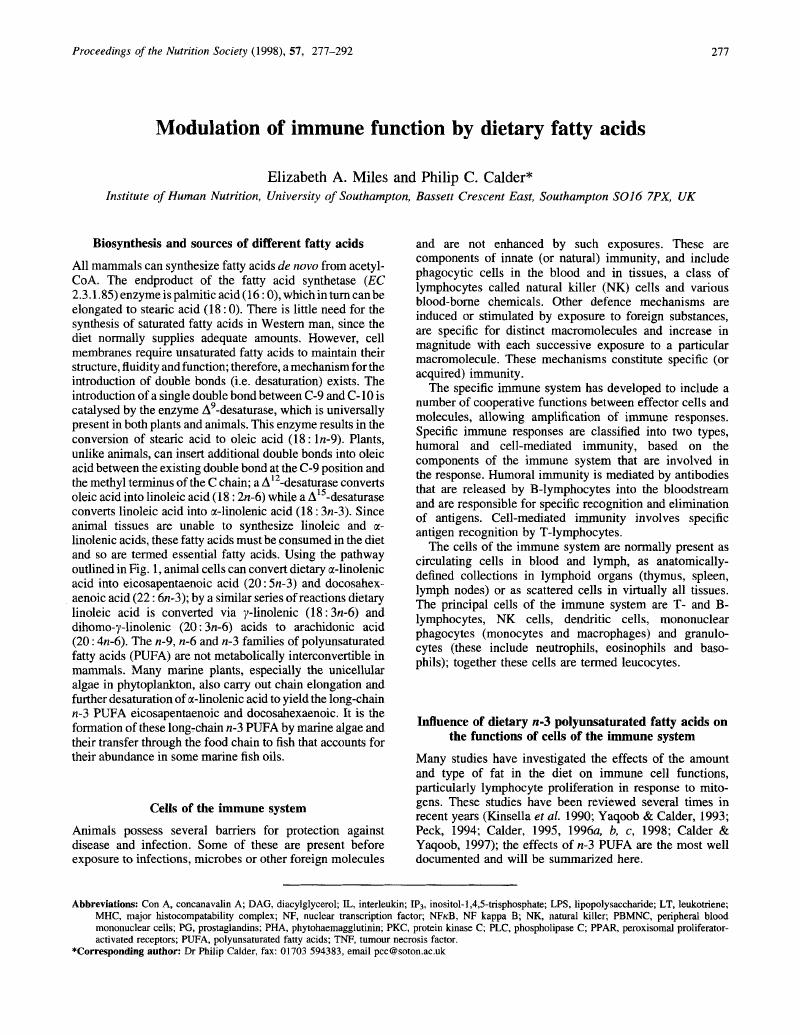Crossref Citations
This article has been cited by the following publications. This list is generated based on data provided by Crossref.
Calder, Philip C.
1998.
Medicinal Fatty Acids in Inflammation.
p.
1.
Calder, Philip C.
1998.
Dietary fatty acids and lymphocyte functions.
Proceedings of the Nutrition Society,
Vol. 57,
Issue. 4,
p.
487.
Venkatraman, Jaya T.
and
Chu, Wei-chia
1999.
Effects of Dietary ω-3 and ω-6 Lipids and Vitamin E on Serum Cytokines, Lipid Mediators and Anti-DNA Antibodies in a Mouse Model for Rheumatoid Arthritis.
Journal of the American College of Nutrition,
Vol. 18,
Issue. 6,
p.
602.
Leskanich, C. O.
and
Noble, R. C.
1999.
The comparative roles of polyunsaturated fatty acids in pig neonatal development.
British Journal of Nutrition,
Vol. 81,
Issue. 2,
p.
87.
Ross, James A.
Moses, Alastair G.W.
and
Fearon, Kenneth C.H.
1999.
The anti-catabolic effects of n-3 fatty acids.
Current Opinion in Clinical Nutrition and Metabolic Care,
Vol. 2,
Issue. 3,
p.
219.
Kelly, F. D.
Mann, N. J.
Turner, A. H.
and
Sinclair, A. J.
1999.
Stearic acid‐rich diets do not increase thrombotic risk factors in healthy males.
Lipids,
Vol. 34,
Issue. S1Part2,
Kearns, Robert J
Hayek, Michael G
Turek, John J
Meydani, Mohsen
Burr, John R
Greene, Robert J
Marshall, Craig A
Adams, Scott M
Borgert, Robert C
and
Reinhart, Gregory A
1999.
Effect of age, breed and dietary omega-6 (n-6):omega-3 (n-3) fatty acid ratio on immune function, eicosanoid production, and lipid peroxidation in young and aged dogs.
Veterinary Immunology and Immunopathology,
Vol. 69,
Issue. 2-4,
p.
165.
Pond, C. M.
and
Newsholme, E. A.
1999.
Coping with metabolic stress in wild and domesticated animals.
BSAP Occasional Publication,
Vol. 24,
Issue. ,
p.
9.
Demeyer, D.
and
Doreau, M.
1999.
Targets and procedures for altering ruminant meat and milk lipids.
Proceedings of the Nutrition Society,
Vol. 58,
Issue. 3,
p.
593.
Volker, Dianne
and
Garg, Manohar
2000.
Handbook of Nutraceuticals and Functional Foods.
Vol. 20004850,
Issue. ,
Hwang, Daniel
2000.
Fatty Acids and Immune Responses—A New Perspective in Searching for Clues to Mechanism.
Annual Review of Nutrition,
Vol. 20,
Issue. 1,
p.
431.
Miles, Elizabeth A.
Wallace, Fiona A.
and
Calder, Philip C.
2000.
Dietary fish oil reduces intercellular adhesion molecule 1 and scavenger receptor expression on murine macrophages.
Atherosclerosis,
Vol. 152,
Issue. 1,
p.
43.
Koletzko, Berthold
2000.
Lipids in Complementary Foods.
Pediatrics,
Vol. 106,
Issue. Supplement_4,
p.
1294.
Richardson, A.J.
and
Puri, B.K.
2000.
The potential role of fatty acids in attention-deficit/hyperactivity disorder.
Prostaglandins, Leukotrienes and Essential Fatty Acids (PLEFA),
Vol. 63,
Issue. 1-2,
p.
79.
Houdijk, Jos G. M.
Jessop, Neil S.
and
Kyriazakis, Ilias
2001.
Nutrient partitioning between reproductive and immune functions in animals.
Proceedings of the Nutrition Society,
Vol. 60,
Issue. 4,
p.
515.
Calder, Philip C.
2001.
Polyunsaturated fatty acids, inflammation, and immunity.
Lipids,
Vol. 36,
Issue. 9,
p.
1007.
Gassull, Miquel A.
2001.
Dietary fat intake and inflammatory bowel disease.
Current Gastroenterology Reports,
Vol. 3,
Issue. 4,
p.
358.
Calder, Philip C.
2001.
The ratio of n-6 to n-3 fatty acids in the diet: Impact on T lymphocyte function.
European Journal of Lipid Science and Technology,
Vol. 103,
Issue. 6,
p.
390.
Nair, Sudheera S.D.
Leitch, James
and
Garg, Manohar L.
2001.
N-3 polyunsaturated fatty acid supplementation alters inositol phosphate metabolism and protein kinase C activity in adult porcine cardiac myocytes.
The Journal of Nutritional Biochemistry,
Vol. 12,
Issue. 1,
p.
7.
Calder, P.C
2001.
N-3 polyunsaturated fatty acids, inflammation and immunity: pouring oil on troubled waters or another fishy tale?.
Nutrition Research,
Vol. 21,
Issue. 1-2,
p.
309.





